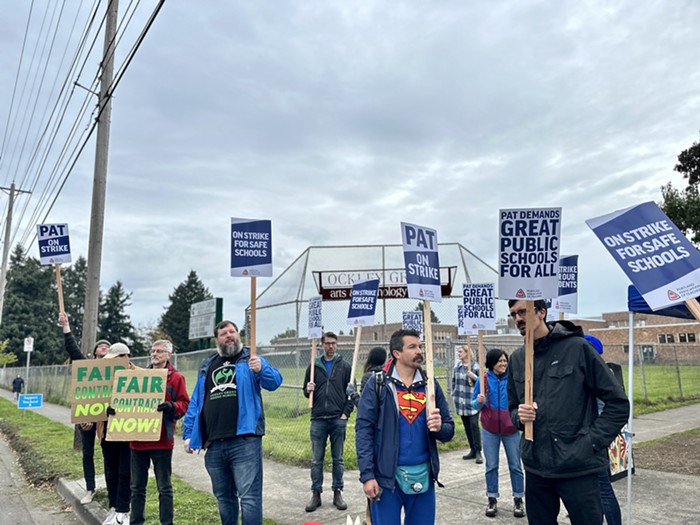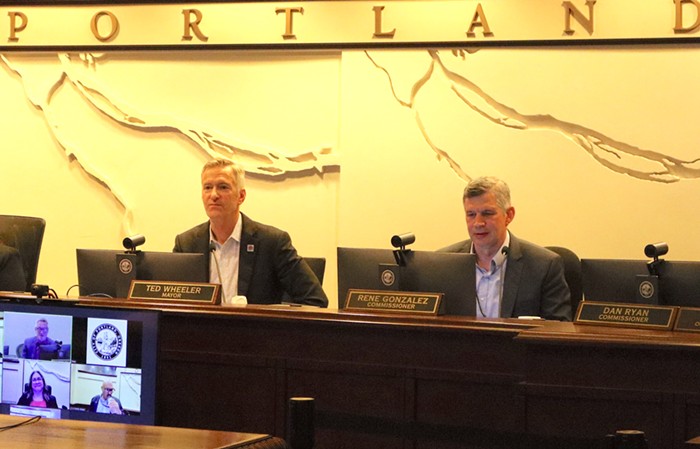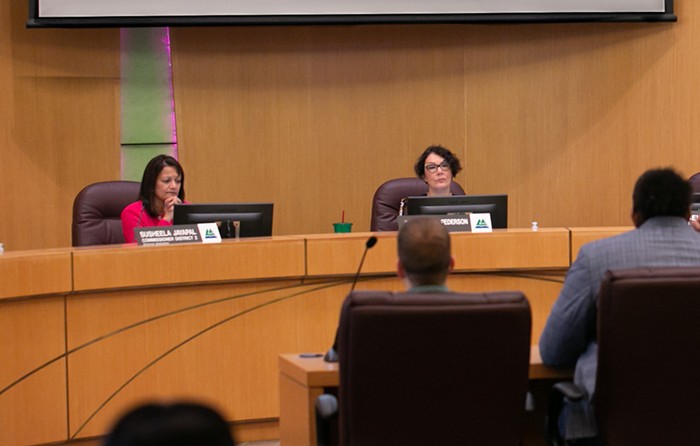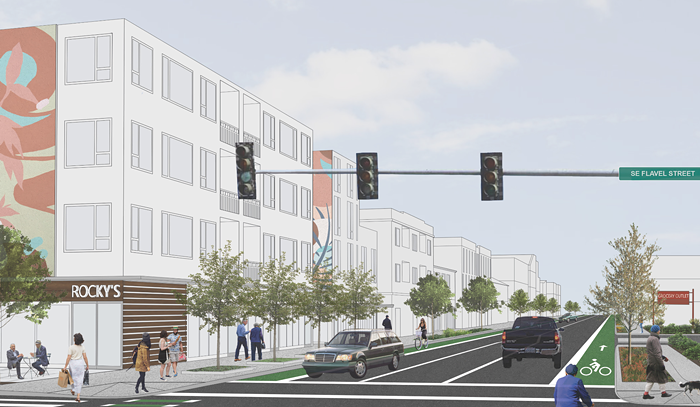Faced with public criticism over its quiet plans to build fewer housing units in South Waterfront for needy Portlanders, the Portland Housing Bureau has just announced, also quietly, that it won't officially be reducing its ambitions in the up-and-coming redevelopment district.
The Oregonian's Brad Schmidt detailed the bureau's plans, contained in an October 28 memo, last Monday. I'd also been working up something on the memo (pdf), which I'd obtained before the O's story went out—and wound up publishing some pointed criticism from the city's former housing commissioner, Nick Fish, in this week's Hall Monitor.
The bureau wrote the memo as part of preparations for a series of changes in urban renewal policy headed before Portland City Council next month. The urban renewal area that holds South Waterfront would expand under the changes, bringing in more money for affordable housing. But even with that expansion, officials worry, the bureau still might not have enough cash to meet housing goals for the area that were first firmed up in 2003.
Instead of building 166 units for people making no more than 30 percent of the region's median family income, the bureau proposed building 72 overall—just 30 more than the 42 it's already got in place. That earned the ire of Fish, who emailed current housing Commissioner Dan Saltzman's office last week (before my column ran) to see if he could help change minds.

Fish argued that the housing bureau, under Saltzman's leadership, was taking the easy way out on a sensitive subject. Cobbling together money for affordable housing, he says, often requires making deals with other nonprofits and governments to craft elaborate, exhausting high-wire deals.
"We are in the middle of a housing crisis and we need to continue to think big," Fish told me. "This is not the time to lower the bar; this is the time to be bold. We should be focusing on strengthening partnerships and lowering costs, not rewriting our housing goals."
Late Friday, Housing Director Traci Manning addressed the issue in a lengthy statement that mostly referenced housing woes in another renewal area, the River District. Starting in 2007, the Oregonian reported, housing officials not only began falling short of their targets for affordable housing but also stopped tracking their progress. Fish oversaw the housing bureau during much of that span. Manning says Saltzman's since ordered up an annual report on citywide housing needs.
Manning's remarks on South Waterfront came near the end of that statement. They include the concession that the housing goals will remain intact. But they also make clear that the bureau is looking at including some "I told you so" estimates alongside them—so in the event those goals aren't actually met, officials can point to their numbers as proof they didn't fall down on the job. (That's not so far-fetched: For the record, the O started charting the struggles in building affordable housing in South Waterfront way back in 2010.)
As the City considers amendments to the North Macadam Urban Renewal Area, the Housing Bureau has supplemented the existing goals in that plan with estimates of what can be achieved with the projected revenue. While the boundary revisions will generate additional revenue for the district, we feel strongly that City Council and the public know what the Set-Aside portion of the proposed revisions will buy in affordable housing. These numbers provide us with a starting point. With a clear picture of the gap between our vision for the area and what we can do with the resources available, we can begin the conversation about what it will take to get the rest of the way. The original District goals will remain part of the document.
Affordable Housing in Portland’s River District
Twenty years ago, City officials outlined a vision to transform miles of vacant land into a vibrant commercial and residential district where Portlanders of all income levels could find a place to live and share in the opportunities it would bring. The River District Housing Implementation Strategy Update that followed in 1999 targeted 5,000 new housing units by 2020 of which at least 1,750 (or 35%) would be affordable. The City has invested in 2,279 new affordable units through 2014. However, the total number of housing units built in the River District Plan area far exceeded that original target of 5,000 units and the volume of affordable housing production has not matched the pace of market development, despite the aspirations and hard work of the many people that fought to make it happen.
Still, holding a vision of a community built for everyone pushed us as a City toward new thinking about sustainable resources for affordable housing. With the urging and support of dedicated community members passionate about affordable housing, City Council established a “Set Aside” policy. By directing 30% of urban renewal dollars toward affordable housing production, Portland established one of the highest set-aside rates for affordable housing in the country. We’ve focused our efforts—and reported on our progress—on leveraging those resources, as well as local and federal resources, to get as many affordable homes built as we can at any given time, irrespective of the booms and busts in the private market. Council reaffirmed its commitment to the 30% Set-Aside in 2011 and has not backed down from that commitment.
But in the midst of what is one of the tightest rental markets in the country, Portlanders are right to worry that we are losing ground. We know that when families have to move from one apartment to another to find affordable rent, and their kids have to change schools, the numbers matter. When someone living with a mental illness can’t find any place that will rent to them, the numbers matter.
The City has invested more public funds in affordable housing in the River District than in any other part of Portland. In part, this has been where resources are available. The River District Set-Aside produced significant resources for affordable housing. It is also a part of the City with substantial amenities and opportunity. We know that people thrive when they live in areas with opportunities and we strive to create housing affordable in those neighborhoods.
We also know that we are falling short of meeting the demand for affordable housing in Portland. Here are some next steps:
Mayor Hales and Commissioner Saltzman directed the Portland Housing Bureau and the Bureau of Planning and Sustainability to provide recommendations to Council on an “Incentive Zoning” proposal that would help us take advantage of the current market boom to add affordability.
The Portland Housing Bureau is working closely with partner Meyer Memorial Trust to learn if there are ways to be more cost effective with the public dollars we invest in affordable housing.
The City, Multnomah County, Gresham, and Home Forward have forged a new partnership that will move aside the boundaries of government to be more impactful in fighting homelessness. Last fall, the City of Portland invested $2 million in new one-time funds to move families, women and vulnerable singles off the street. In the current budget, Council made $500,000 of that investment on-going and invested another $1 million in one-time funds for the production of affordable housing, with proposals being accepted now.
Finally, as the City considers amendments to the North Macadam Urban Renewal Area, the Housing Bureau has supplemented the existing goals in that plan with estimates of what can be achieved with the projected revenue. While the boundary revisions will generate additional revenue for the district, we feel strongly that City Council and the public know what the Set-Aside portion of the proposed revisions will buy in affordable housing. These numbers provide us with a starting point. With a clear picture of the gap between our vision for the area and what we can do with the resources available, we can begin the conversation about what it will take to get the rest of the way. The original District goals will remain part of the document.
Frequently Asked Questions
What was the goal for affordable housing production in the 1994 River District Plan?
The 1994 River District Housing Implementation Strategy was adopted by the Portland City Council, and had a target of 35-55% of the total new units developed as affordable to households whose incomes are 80% of area median family income (MFI) and under.
How is that different than the Hoyt Street Development Agreement?
The Hoyt Street Development Agreement covered property within the River District owned by Hoyt Street Properties. The 1999 agreement required that Hoyt Street Properties make land available for the development of 35% of the units affordable at 80% MFI and under. The City subsidized the development of the units. If the percentage of affordable units was not reached, the agreement provides an opportunity for the City to acquire land for affordable housing at a below-market price from Hoyt Street Properties. 28% of the units produced were affordable. PHB is overseeing the fulfillment of that remedy with the cooperation of Hoyt Street Properties.
How does the City report on its progress?
The last report against the 1994 River District Plan was published in 2008. At the time, PDC’s Director recommended discontinuing the report as the total housing goal for the plan, projected for 2020, had already been reached. He proposed a new Housing Strategy be created. That recommendation was not taken up for the geography of the prior plan. PHB tracks affordable housing production against the goals of the River District Set-Aside and the Downtown Waterfront Set-Aside, the two Urban Renewal areas that today cover the geography described in the Plan.
Housing Commissioner Dan Saltzman has directed the Portland Housing Bureau to create an Annual Housing Report for Council. Starting this spring, the report will be designed to give Council the information they need to make housing policy, including supply of housing city-wide and by sub-markets, as well as need, equity, current production, annual reporting on the TIF Set-Aside, and other market and policy information. He has not directed PHB to resume reporting on the 1994 River District Plan as reported in the Oregonian.


















